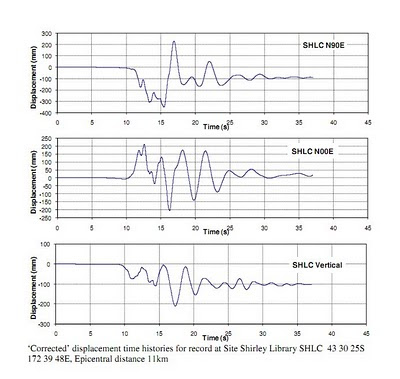Reference
I've been waiting for these. For anywhere else in the world, we should not expect much damage for an M6.3. However, the general statement is that the buildings were fine, but were exposed to 2g acceleration, which is almost a world record, and allows one to throw up hands.
As we look at the records, we see that nearly all of them have permanent displacements. This throws out the use of response spectrum methods. Engineers should not quote those spectral accelerations.
This is the most reasonable record, with minimal permanent displacement in the N-S direction (middle). I'm going with 80 cm/s with the cleanest velocity pulse yet. I'm using this one for analysis.
The displacement is a very minimal cycle, and demolishes all assumptions about response spectra and sinusoids. Nevertheless, the engineers will stick with tradition.
This can also be used as an input for explicit analysis. 20 cm of displacement is more like the centre of the Chile earthquake (M8.8). In fact, as I think about it, these records are almost exact duplicates of the max. Chile records. Remember that at the Chile epicentre, all modern soft-story buildings (cheap condos) collapsed, and were slated for the dump, farther out in Santiago at 40 cm/s. The integrated records showed 3m of permanent displacement at the epicentre.
I still believe that the 80 cm/s for Christchurch was amplified by a factor of 10. Really, we only expect 10-20 cm/s for an M6.3, and these small things rarely go super-shear.


4 comments:
That is facinating stuff. So, I assume these massive displacements are due to the muck that the city is built on. I have been trying to get info on the depth of the saturated sands in Christchurch but can't find a source. Any idea where I met get this info? How much displacement and velocity can we expect for our Queenston shale and silty clay soils (N15-30) around here?
Don't have a clue. More interesting is the n-count profile. Houses built on piles have done well.
In Toronto, we can expect an amplification of 2-3 for the hanging-wall shale, and 10 for the swamps, such as the Beaches. This earthquake in Hamilton should give 10 cm/s on the hangingwall rock.
Is High Park considered to be part of the swamps? I know the soil is sandy but we're elevated from the lake.
High Park is loose saturated sands. When they put in an old folks home there 30 years ago, they ran into quicksand, and had to delay over a year. And nobody tuckpoints their chimneys! From the subway you can see right through them! The pond is a quicksand spring. I had a house there, and I noticed a lot had settlement problems. I would make sure your brick is solid, secure your cabinets and knick-knacks, and take out earthquake insurance.
Post a Comment